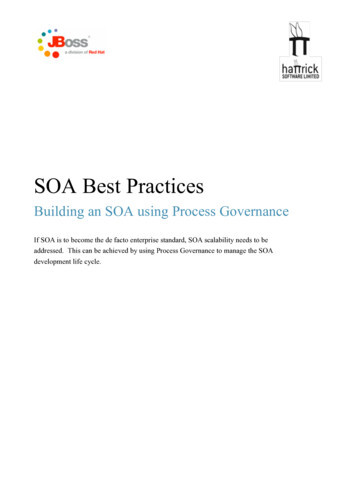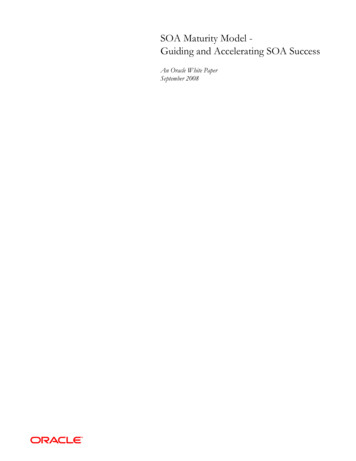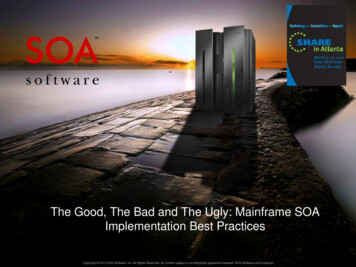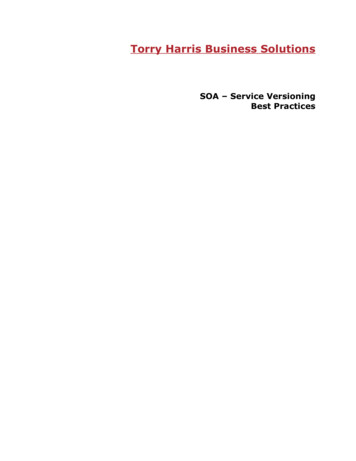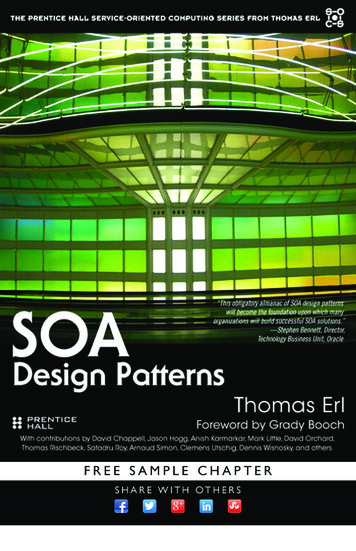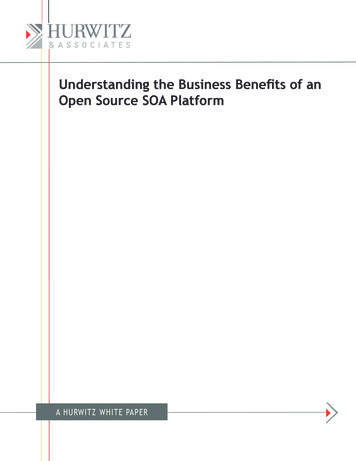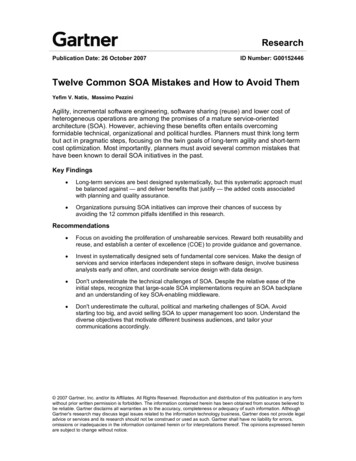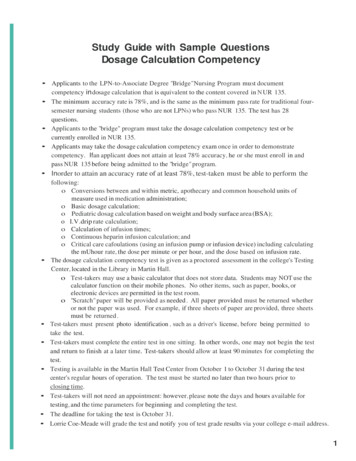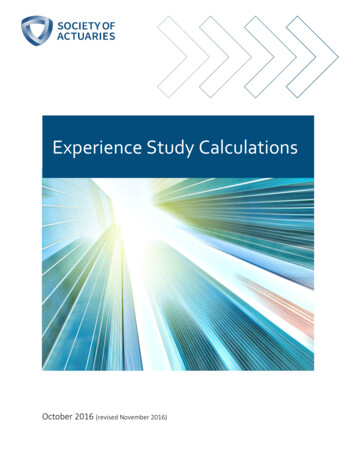
Transcription
Experience Study CalculationsOctober 2016 (revised November 2016)
2Experience Study CalculationsAUTHORSDAVID B. ATKINSON, FSA, MBAJOHN K. MCGARRY, ASA, PhDCaveat and DisclaimerThis paper is published by the Society of Actuaries (SOA) and contains information from a variety of sources. The paper is for informational purposes only and shouldnot be construed as professional or financial advice. The SOA does not recommend or endorse any particular use of the information provided in this study. The SOAmakes no warranty, express or implied, or representation whatsoever and assumes no liability in connection with the use or misuse of this study.Copyright 2016 All rights reserved by the Society of Actuaries 2016 Society of Actuaries
3TABLE OF CONTENTSPreface: Revisions Made to this Report Subsequent to October 2016 . 6November 2014 Updates . 61Acknowledgements . 72Introduction . 82.1 Scope . 82.2 Guide to Usage . 83Experience Study Overview . 103.1 Basic Terminology. 103.2 Experience Study Segmentation . 114Simple Mortality Study Examples . 134.1 Cohort Study with Deaths only . 134.1.1Summary Rates with Deaths Only . 144.2 Cohort Study with Deaths and Withdrawals . 144.2.1Individual Exposure Calculation . 164.2.2Grouped Exposure Calculation. 174.2.3Summary Rates with Deaths and Withdrawals . 184.3 Period Study with Deaths and Withdrawals . 184.3.1Individual Exposure Calculation . 194.3.2Grouped Exposure Calculation. 204.4 Amount-Weighted Studies. 224.4.1Individual Amount Weights . 224.4.2Grouped Amount Weights . 235Distributed Exposure . 255.1 Period Study. 266Fractional Rates . 276.1 Half-Year Period Study . 286.2 Average Fractional Rates. 286.3 Annual Period Study by Calendar Year . 317Average Daily Rates and Exposure . 337.1 Period Study with Daily Exposure . 348Average Force of Mortality . 358.1 Period Study with Constant Force . 368.2 Changing Force of Mortality . 369Distributions of Deaths . 399.1 Comparison of Distributions . 409.1.1Balducci Hypothesis . 419.1.2Uniform Distribution of Deaths . 439.1.3Constant Mortality Rates. 449.1.4Increasing Force . 459.2 Estimating Errors . 4810Decrement Studies . 5110.1 Decrement Types. 5110.2 Rate Intervals . 5110.2.1 Partial Rate Intervals . 5210.3 Time Intervals . 5310.4 Discrete Decrements . 5410.5 Population States. 54 2016 Society of Actuaries
411Simple Withdrawal Study Example . 5611.1 Period Study. 5611.1.1 Exposure Calculation . 5612Actual To Expected Analysis . 5812.1 Period Study with Deaths and Withdrawals . 5912.2 Amount-Weighted Period Study. 5912.3 Period Study with Calendar Year . 6012.4 Half-Year Study . 6012.5 Half-Year Study with Daily Decrement Rates . 6113Central Rates . 6313.1 Annual Period Study . 6413.2 Force of Decrement. 6514Dependent Rates . 6614.1 Cohort Study with Deaths and Withdrawals . 6614.2 Period Study with Deaths and Withdrawals . 6714.3 Population Projection . 6914.4 Formula Derivation . 7015Utilization Studies . 7215.1 Frequency and Severity . 7215.2 Utilization of Maximum Limits . 7315.3 Loss Ratio . 7415.4 Variable Annuity Withdrawal Utilization . 7416Exposure and Rate Comparisons . 7617Practical Considerations . 7817.1 Amount-Weighted Distortions. 7817.2 Data Extracts for Multi-Year Studies . 7817.3 Homogeneity of Data . 7817.4 Reporting Lags . 7917.5 Non-Uniform Distribution of Events . 8017.6 Partial Policy Years. 8017.6.1 Overview . 8017.6.2 Inclusion of Partial Policy Years . 8117.6.3 Overview of Exposure Methods . 8117.6.4 Annual Exposure Method . 8117.6.5 Distributed Exposure Method . 8218Product-Related Considerations . 8418.1 Individual Life Insurance . 8418.1.1 Grace Period. 8418.1.2 Compromised and Denied Claims . 8418.1.3 Study Variables Changing Over Time . 8418.1.4 Treatment of Reinsured Amounts . 8518.1.5 Use of Net Amount at Risk . 8518.1.6 Inclusion of Substandard or Uninsurable Lives . 8518.1.7 Backdated New Business . 8518.2 Group Life Insurance . 8618.3 Morbidity Products. 8618.3.1 Claim Incidence Studies . 8718.3.2 Claim Severity Studies . 8718.3.3 Claim Termination Studies . 8718.4 Disability Income . 8818.4.1 Elimination Periods . 88 2016 Society of Actuaries
518.518.618.718.818.918.4.2 Partial Disability Benefits . 8918.4.3 Recovery Followed by Relapse . 8918.4.4 Claim Settlements . 8918.4.5 Other DI Considerations . 89Long-Term Care . 9018.5.1 Elimination Period. 9018.5.2 Inflation Protection . 9018.5.3 Benefit Utilization Rate . 9018.5.4 Other LTC Considerations . 91Deferred Annuities . 9118.6.1 Deferred Annuity Utilization Rates . 9218.6.2 Contract Year Data Challenges . 92Payout Annuities. 93Retirement Pensions . 93Credit Life and Disability . 9418.9.1 Credit Life Insurance . 9418.9.2 Credit Disability Income. 9519Standard Method Error Derivation . 9619.1 Errors from Fractional Exposure Method . 9619.1.1 Error for Partial Year Running from Age 𝒙 to 𝒙 𝒔 . 9619.1.2 Error for Partial Year Running from Age 𝒙 𝒔 to 𝒙 𝟏 . 9719.1.3 Error for Fractional Period. 9819.2 Errors for Annual Exposure Method. 9919.2.1 Error for Partial Year Running from Age 𝒙 𝒔 to 𝒙 𝟏 . 9919.2.2 Error for Partial Year Running from Age 𝒙 to 𝒙 𝒔 . 10019.2.3 Error for Fractional Period. 10119.3 Errors from Distributed Exposure Method . 10219.3.1 Error for Partial Year Running from Age 𝒙 to 𝒙 𝒔 . 10219.3.2 Error for Partial Year Running from Age 𝒙 𝒔 to 𝒙 𝟏 . 10319.3.3 Error for Fractional Period. 10420Linear Force Method . 10620.1 Formula Development . 10620.1.1 Partial Year Running from Age 𝒙 to 𝒙 𝒔 . 10620.1.2 Partial Year from Age 𝒙 𝒔 to 𝒙 𝟏 . 10720.1.3 Fractional Periods . 10820.2 Increasing Force Example . 10921Glossary . 11022About The Society of Actuaries . 114 2016 Society of Actuaries
6Preface: Revisions Made to this Report Subsequent to October 2016November 2014 Updates Credentials have been added to the names of the members of the Project Oversight Group onpage 7. Formula in the middle of page 21,½ 𝑙66 ½ ½ 𝑑65½ ¼ ½ 𝑤65½ Other minor wording clarifications have been made throughout the document.½ 𝐸65½ ½𝑙66 ½ 𝑑65½ ¼ ½ 𝑤65½ , corrected to be½ 𝐸65½ 2016 Society of Actuaries
71AcknowledgementsThe Society of Actuaries (SOA) and the authors extend their gratitude to the following members of the ProjectOversight Group who contributed their expertise and insights, served as a sounding board for ideas and oversawthe development of this report.Project Oversight Group: John A. Bettano, FSA, MAAA Carl Desrochers, FSA, MAAA, FCIA Steven C. Ekblad, FSA, MAAA Christopher H. Hause, FSA, MAAA Barry M. Koklefsky, FSA, MAAA, FCIA Michael J. Lane, FSA, MAAA Marianne C. Purushotham, FSA, MAAA Joel C. Sklar, ASA, MAAASOA Staff:Cynthia MacDonald, FSA, MAAAKorrel Rosenberg 2016 Society of Actuaries
82Introduction2.1 ScopeThe design and maintenance of insurance programs, pensions and many forms of finance are underpinned by ratesof many different sorts, such as interest rates, mortality rates and claim utilization rates. This paper presents andexplains the methods for determining rates based on experience, such as mortality and claim utilization rates. Whilethis paper can be applied to calculate certain rates related to asset behavior, such as default and prepayment rates,it does not apply to rates based on elaborate econometric models, such as those sometimes used for interest rates,convexity and the like.The objective of experience studies is to develop rates or probabilities based on data collected from sources such asinsurance companies, consulting firms, or governmental bodies. These rates and probabilities can be used byactuaries to develop assumptions for financial planning, valuation, pricing and risk management.Many types of experience studies take place on a regular basis. While most companies perform their own studies,the most far-reaching studies are those that gather data from across an industry: Many large life insurers regularly contribute data that is compiled to produce industry mortality studies every fewyears. Additionally, many life insurers perform mortality studies using their own data, with results often comparedto industry averages.Insurers perform annual claim utilization studies of both frequency and severity of claims. Annual studies areneeded to keep up with rapid changes in the use and cost of medical services. Separate studies are oftenperformed for large employers.Because of the relatively high volume of lapses and significant variations by company, most life insurers performtheir own lapse studies rather than relying on industry studies, which are produced less frequently.Pension mortality studies are done to provide current information across employers for use in setting pension planvaluation assumptions. Due to some difficulty in gathering data from employers, these studies have historicallybeen performed less often than life insurance mortality studies.Products with smaller market shares and fewer market participants, such as Long Term Care (LTC) and IndividualDisability Income (IDI), tend to have less frequent studies. Additionally, such products present complexities notfound in life insurance.U.S. insurers of credit life, credit disability and deferred annuity products use consulting firms to conductexperience studies for these products, with a high level of industry participation.The goal of this report is to illuminate the calculations that underlie such studies.2.2 Guide to UsageThis report can be used in different ways:1.2.3.It can be used as a primer to learn about the fundamentals of experience rate calculations or as an aid whenbuilding a new experience study from scratch. For these purposes, the reader may want to focus on thefundamental chapters outlined below.It can serve as a resource for a practitioner looking for new ideas or wanting to validate a new or existingapproach. A scan of the Table of Contents or a search for key words should lead the reader to areas of interest.Those skeptical of the Annual Exposure Method (often called the “Actuarial Method”) can see how it compares toalternative methods. Someone looking for the most appropriate exposure method for a particular situation canreview the pros and cons of each method. Chapters 5 through 9 examine and compare the various exposuremethods, Chapter 19 derives error formulas for each exposure method and Chapter 20 presents the “linear force 2016 Society of Actuaries
9method,” a new approach to modeling rates that change continuously over time and facilitates the estimation oferrors.The fundamentals of experience rate calculations are covered by the following chapters: Chapter 3, Experience Study OverviewChapter 4, Simple Mortality Study ExamplesChapter 11, Simple Withdrawal Study ExampleChapter 12, Actual to Expected AnalysisAdditionally, it is recommended that the reader scan Chapter 17, Practical Considerations, and Chapter 18, ProductRelated Considerations, for relevant topics. 2016 Society of Actuaries
103Experience Study Overview3.1 Basic TerminologyThis paper uses the following terms to describe the calculations for experience studies:Study Period: The period of time for which data has been gathered for the experience study. Study periods mostcommonly consist of one to many calendar years of data. When multiple years are included, it is possible to studytrends.Study Population: The population from which the experience study’s data has been drawn. The population wouldnormally consist of people (insureds, employees, retirees, citizens, etc.) or contracts (individual insurance policies,pension plans, group insurance plans, bonds, mortgages, etc.).Cell: An experience study is typically subdivided into many cells. For example, an experience study might subdivideits data into cells for each combination of issue age, sex, smoker/nonsmoker, and policy year.Experience Rates: The main results of an experience study. Most often, an experience rate is either a decrement rateor a utilization rate. One experience rate is calculated for each cell in the study.Rate Interval: The cell’s experience rate is calculated for an interval of time. While the most common rate intervalsare annual and monthly, other intervals such as daily and weekly are sometimes used. The interval is chosen tocapture important variations of rates over time, as in the following examples: While most financial products use annual rate intervals, there are exceptions. Deferred annuities are moreapt to be surrendered, with the proceeds invested in a new contract, in the months after a surrendercharge runs out. Insurance products are more prone to lapsation in the month or two after a steeppremium increase takes effect. In such cases, an analysis of the policyholder behavior for a monthly rateinterval may be required to accurately represent the experience. Some products offer a benefit that changes monthly, such as credit insurance designed to pay off anamortizing loan. A monthly study interval would better reflect the decreasing benefit amounts. Disability recovery rates change dramatically in the early stages of disability, so monthly or weekly rateintervals are used for the first two or more years following the onset of disability. Once recovery ratesstabilize, annual rate intervals are used.Rate Year: The type of year upon which rates are based. Rate year is usually a policy year, life year or calendar year: Policy Year: Cells are defined with reference to the underlying contract’s date of inception. Policy year 1 isthe first policy year. Policy year t starts at t-1 years after inception and ends just prior to t years afterinception. Most individual insurance studies use policy years. When the data underlying the study issubmitted by calendar year, there will be partial policy years at the beginning and end of the study. In somestudies, policy years are referred to as policy durations. Sometimes duration and policy year aresynonymous. Other times, duration is equal to
found in life insurance. U.S. insurers of credit life, credit disability and deferred annuity products use consulting firms to conduct experience studies for these products, with a high level of industry participation. The goal of this report is to illuminate the calculations that underlie such studies.

